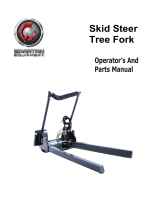Page is loading ...

FormNo.3357-140RevA
TX420andTX425Compact
UtilityLoader
ModelNo.22331—SerialNo.280000001andUp
ModelNo.22332—SerialNo.280000001andUp
Registeratwww.Toro.com.OriginalInstructions(EN)

ThissparkignitionsystemcomplieswithCanadian
ICES-002.
Introduction
Readthisinformationcarefullytolearnhowtooperate
andmaintainyourproductproperlyandtoavoidinjury
andproductdamage.Youareresponsibleforoperating
theproductproperlyandsafely.
YoumaycontactTorodirectlyatwww .Toro.comfor
productandaccessoryinformation,helpndinga
dealer,ortoregisteryourproduct.
Wheneveryouneedservice,genuineToroparts,or
additionalinformation,contactanAuthorizedService
DealerorToroCustomerServiceandhavethemodel
andserialnumbersofyourproductready.Themodel
andserialnumbersarestampedintoaplatemounted
underthehoodnearthebeltdrive.Writethenumbers
inthespaceprovided.
ModelNo.
SerialNo.
Thismanualidentiespotentialhazardsandhas
safetymessagesidentiedbythesafetyalertsymbol
(Figure1),whichsignalsahazardthatmaycauseserious
injuryordeathifyoudonotfollowtherecommended
precautions.
Figure1
1.Safetyalertsymbol
Thismanualuses2otherwordstohighlightinformation.
Importantcallsattentiontospecialmechanical
informationandNoteemphasizesgeneralinformation
worthyofspecialattention.
Contents
Introduction.................................................................2
Safety...........................................................................3
SafeOperatingPractices.......................................3
SoundPressure.....................................................6
SoundPower........................................................6
Vibration..............................................................6
SlopeChart..........................................................7
SafetyandInstructionalDecals.............................8
Setup..........................................................................11
1ActivatingtheBattery......................................11
2CheckingFluidLevels......................................12
ProductOverview......................................................13
Controls.............................................................13
Specications.....................................................17
Attachments/Accessories...................................17
StabilityData......................................................18
Operation...................................................................19
AddingFuel.......................................................19
CheckingtheEngineOilLevel............................20
CheckingtheHydraulicFluidLevel.....................20
StartingandStoppingtheEngine........................21
StoppingtheTractionUnit.................................21
MovingaNon-functioningTraction
Unit................................................................21
UsingtheCylinderLock.....................................22
UsingAttachments.............................................22
SecuringtheTractionUnitforTransport.............24
LiftingtheTractionUnit.....................................24
Maintenance...............................................................25
RecommendedMaintenanceSchedule(s)................25
PremaintenanceProcedures....................................26
OpeningtheHood.............................................26
ClosingtheHood...............................................26
OpeningtheRearAccessCover..........................26
ClosingtheRearAccessCover............................27
RemovingtheSideScreens.................................27
InstallingtheSideScreens...................................27
RemovingtheFrontScreen................................27
Lubrication.............................................................29
GreasingtheTractionUnit.................................29
EngineMaintenance...............................................29
ServicingtheAirCleaner....................................29
ServicingtheEngineOil.....................................30
ServicingtheSparkPlugs....................................31
FuelSystemMaintenance.......................................32
ChangingtheFuelFilter.....................................32
DrainingtheFuelTank.......................................33
ElectricalSystemMaintenance................................33
ServicingtheBattery...........................................33
DriveSystemMaintenance.....................................35
ServicingtheTracks............................................35
©2008—TheToro®Company
8111LyndaleAvenueSouth
Bloomington,MN55420
2
Contactusatwww.Toro.com.
PrintedintheUSA.
AllRightsReserved

BeltMaintenance....................................................38
Inspecting/ReplacingtheDriveBelt...................38
ControlsSystemMaintenance.................................40
AdjustingtheTractionControl
Alignment......................................................40
AdjustingtheTractionControlNeutral
Position..........................................................40
AdjustingtheTrackingoftheTraction
Control,FullForwardPosition........................41
HydraulicSystemMaintenance...............................42
ReplacingtheHydraulicFilter.............................42
ChangingtheHydraulicFluid.............................42
CheckingtheHydraulicLines.............................43
Cleaning.................................................................44
RemovingDebrisfromtheTraction
Unit................................................................44
CleaningtheChassis...........................................44
Storage.......................................................................46
Troubleshooting.........................................................47
Schematics.................................................................48
Safety
Improperuseormaintenancebytheoperatoror
ownercanresultininjury.Toreducethepotential
forinjury,complywiththesesafetyinstructions
andalwayspayattentiontothesafetyalert
symbol
,whichmeans:
Caution
,
W ar ning
,or
Danger
—personalsafetyinstruction.Failureto
complywiththeinstructionmayresultinpersonal
injuryordeath.
SafeOperatingPractices
Thisproductiscapableofamputatinghandsandfeet.
Alwaysfollowallsafetyinstructionstoavoidserious
injuryordeath.
Engineexhaustcontainscarbonmonoxide,an
odorless,deadlypoisonthatcankillyou.
Donotruntheengineindoorsorinanenclosed
area.
Training
•ReadtheOperator’sManualandothertraining
material.Iftheoperator(s)ormechanic(s)can
notreadEnglish,itistheowner’sresponsibilityto
explainthismaterialtothem.
•Becomefamiliarwiththesafeoperationofthe
equipment,operatorcontrols,andsafetysigns.
•Alloperatorsandmechanicsshouldbetrained.The
ownerisresponsiblefortrainingtheusers.
•Neverletchildrenoruntrainedpeopleoperateor
servicetheequipment.Localregulationsmayrestrict
theageoftheoperator.
•Theowner/usercanpreventandisresponsiblefor
accidentsorinjuriesoccurringtohimselforherself,
otherpeopleorproperty.
Preparation
•Evaluatetheterraintodeterminewhataccessories
andattachmentsareneededtoproperlyand
safelyperformthejob.Onlyuseaccessoriesand
attachmentsapprovedbythemanufacturer.
•Wearappropriateclothingincludinghardhat,
safetyglasses,longpants,safetyshoes,andhearing
protection.Longhair,looseclothingorjewelrymay
gettangledinmovingparts.
3

•Inspecttheareawheretheequipmentistobeused
andremoveallobjectssuchasrocks,toys,andwire
whichcanbethrownbythemachine.
•Useextracarewhenhandlinggasolineandother
fuels.Theyareammableandvaporsareexplosive.
–Useonlyanapprovedcontainer
–Neverremovethegascaporaddfuelwiththe
enginerunning.Allowtheenginetocoolbefore
refueling.Donotsmoke.
–Neverrefuelordrainthemachineindoors.
•Checkthattheoperator’spresencecontrols,safety
switches,andshieldsareattachedandfunctioning
properly.Donotoperateunlesstheyarefunctioning
properly.
Operation
•Neverrunanengineinanenclosedarea.
•Onlyoperateingoodlight,keepingawayfromholes
andhiddenhazards.
•Besurealldrivesareinneutralandparkingbrakeis
engagedbeforestartingtheengine.Onlystartthe
enginefromtheoperator’sposition.
•Slowdownanduseextracareonhillsides.Besure
totravelintherecommendeddirectiononhillsides.
Turfconditionscanaffectthemachine’sstability.
•Slowdownandusecautionwhenmakingturnsand
whenchangingdirectionsonslopes.
•Neveroperatewiththeguardsnotsecurelyinplace.
Besureallinterlocksareattached,adjustedproperly,
andfunctioningproperty.
•Donotchangetheenginegovernorsettingor
overspeedtheengine.
•Stoponlevelground,lowerimplements,disengage
theauxiliaryhydraulics,engageparkingbrake,shut
offtheenginebeforeleavingtheoperator’sposition
foranyreason.
•Keephandsandfeetawayfrommovingattachments.
•Lookbehindanddownbeforebackinguptobesure
ofaclearpath.
•Nevercarrypassengersandkeeppetsandbystanders
away.
•Slowdownandusecautionwhenmakingturnsand
crossingroadsandsidewalks.
•Donotoperatethemachineundertheinuenceof
alcoholordrugs.
•Usecarewhenloadingorunloadingthemachine
intoatrailerortruck.
•Usecarewhenapproachingblindcorners,shrubs,
trees,orotherobjectsthatmayobscurevision.
•Readallattachmentmanuals.
•Ensurethattheareaisclearofotherpeoplebefore
operatingthetractionunit.Stopthetractionunit
ifanyoneentersthearea.
•Neverleavearunningtractionunitunattended.
Alwayslowertheloaderarms,stoptheengine,set
theparkingbrake,andremovethekeybeforeleaving.
•Donotexceedtheratedoperatingcapacity,asthe
tractionunitmaybecomeunstablewhichmayresult
inlossofcontrol.
•Donotcarryaloadwiththearmsraised.Always
carryloadsclosetotheground.
•Donotoverloadtheattachmentandalwayskeep
theloadlevelwhenraisingtheloaderarms.Logs,
boards,andotheritemscouldrolldowntheloader
arms,injuringyou.
•Neverjerkthecontrols;useasteadymotion.
•Watchfortrafcwhenoperatingnearorcrossing
roadways.
•Donottouchpartswhichmaybehotfrom
operation.Allowthemtocoolbeforeattemptingto
maintain,adjust,orservice.
•Checkforoverheadclearances(i.e.branches,
doorways,electricalwires)beforedrivingunderany
objectsanddonotcontactthem.
•Ensurethatyouoperatethetractionunitinareas
wheretherearenoobstaclesincloseproximitytothe
operator.Failuretomaintainadequatedistancefrom
trees,walls,andotherbarriersmayresultininjury
asthetractionunitbacksupduringoperationifthe
operatorisnotattentivetothesurroundings.Only
operatetheunitinareaswherethereissufcient
clearancefortheoperatortosafelymaneuverthe
product.
•Beforedigging,havetheareamarkedfor
undergroundutilities,anddonotdiginmarkedareas.
•Locatethepinchpointareasmarkedonthetraction
unitandattachmentsandkeephandsandfeetaway
fromtheseareas.
•Beforeoperatingthetractionunitwithan
attachment,ensurethattheattachmentisproperly
installed.
SlopeOperation
Slopesareamajorfactorrelatedtoloss-of-controland
tip-overaccidents,whichcanresultinsevereinjuryor
death.Allslopesrequireextracaution.
•Donotoperatethetractionunitonhillsidesor
slopesexceedingtheanglesrecommendedinthe
StabilityDatasectioninSpecications,page17,and
4

thoseintheattachmentOperator’sManual.Seealso
theSlopeChart,page7.
•Operateupanddownslopeswiththeheavyend
ofthetractionunituphill.Weightdistribution
changes.Anemptybucketwillmaketherearof
thetractionunittheheavyend,andafullbucket
willmakethefrontofthetractionunittheheavy
end.Mostotherattachmentswillmakethefrontof
tractionunittheheavyend.
•Raisingtheloaderarmsonaslopewillaffectthe
stabilityofthemachine.Wheneverpossible,keepthe
loaderarmsintheloweredpositionwhenonslopes.
•Removinganattachmentonaslopewillmakethe
rearofthetractionunitheavy.RefertotheStability
DatasectioninSpecications,page17,todetermine
whethertheattachmentcanbesafelyremovedon
theslope.
•Removeobstaclessuchasrocks,treelimbs,etc.from
theworkarea.Watchforholes,ruts,orbumps,as
uneventerraincouldoverturnthetractionunit.Tall
grasscanhideobstacles.
•UseonlyToro-approvedattachments.Attachments
canchangethestabilityandtheoperating
characteristicsofthetractionunit.Warrantymaybe
voidedifusedwithunapprovedattachments.
•Keepallmovementsonslopesslowandgradual.Do
notmakesuddenchangesinspeedordirection.
•Avoidstartingorstoppingonaslope.Ifthetraction
unitlosestraction,proceedslowly,straightdownthe
slope.
•Avoidturningonslopes.Ifyoumustturn,turn
slowlyandkeeptheheavyendofthetractionunit
uphill.
•Donotoperateneardrop-offs,ditches,or
embankments.Thetractionunitcouldsuddenlyturn
overifatrackgoesovertheedgeofaclifforditch,
orifanedgecavesin.
•Donotoperateonwetgrass.Reducedtractioncould
causesliding.
•Donotparkthetractionunitonahillsideorslope
withoutloweringtheattachmenttotheground,
settingtheparkingbrake,andchockingthetracks.
MaintenanceandStorage
•Disengagetheauxiliaryhydraulics,lowerthe
attachment,settheparkingbrake,stoptheengine,
andremovethekey.Waitforallmovementtostop
beforeadjusting,cleaning,orrepairing.
•Cleandebrisfromattachments,drives,mufers,and
enginetohelppreventres.Cleanupoilorfuel
spillage.
•Lettheenginecoolbeforestoringanddonotstore
nearame.
•Donotstorefuelnearamesordrainindoors.
•Parkthemachineonlevelground.Neverallow
untrainedpersonneltoservicethemachine.
•Usejackstandstosupportcomponentswhen
required.
•Carefullyreleasepressurefromcomponentswith
storedenergy.
•Disconnectthebatteryorremovethesparkplug
wiresbeforemakinganyrepairs.Disconnect
thenegativeterminalrstandthepositivelast.
Reconnectpositiverstandnegativelast.
•Keephandsandfeetawayfrommovingparts.If
possible,donotmakeadjustmentswiththeengine
running.
•Chargebatteriesinanopenwellventilatedarea,away
fromsparkandames.Unplugthechargerbefore
connectingordisconnectingitfromthebattery.
Wearprotectiveclothinganduseinsulatedtools.
•Keepallpartsingoodworkingconditionandall
hardwaretightened.Replaceallwornordamaged
decals.
•Ifanymaintenanceorrepairrequirestheloaderarms
tobeintheraisedposition,securethearmsinthe
raisedpositionwiththehydrauliccylinderlock.
•Securetheloaderarmvalvewiththeloadervalve
lockanytimeyouneedtostopthemachinewiththe
loaderarmsraised.
•Keepnutsandboltstight.Keepequipmentingood
condition.
•Nevertamperwithsafetydevices.
•Keepthetractionunitfreeofgrass,leaves,orother
debrisbuildup.Cleanupoilorfuelspillage.Allow
thetractionunittocoolbeforestoring.
•Useextracarewhenhandlinggasolineandother
fuels.Theyareammableandvaporsareexplosive.
–Useonlyanapprovedcontainer.
–Neverremovethegascaporaddfuelwhen
theengineisrunning.Allowtheenginetocool
beforerefueling.Donotsmoke.
–Neverrefuelthetractionunitindoors.
–Neverstorethetractionunitorfuelcontainer
insidewherethereisanopename,suchasnear
awaterheaterorfurnace.
–Neverllacontainerwhileitisinsideavehicle,
trunk,pickupbed,oranysurfaceotherthanthe
ground.
5

–Keepcontainernozzleincontactwiththetank
duringlling.
•Stopandinspecttheequipmentifyoustrikean
object.Makeanynecessaryrepairsbeforerestarting.
•UseonlygenuineTororeplacementpartstoensure
thatoriginalstandardsaremaintained.
•Batteryacidispoisonousandcancauseburns.Avoid
contactwithskin,eyes,andclothing.Protectyour
face,eyes,andclothingwhenworkingwithabattery.
•Batterygasescanexplode.Keepcigarettes,sparks
andamesawayfromthebattery.
•Keepyourbodyandhandsawayfrompinhole
leaksornozzlesthatejecthighpressurehydraulic
uid.Usecardboardorpapertondhydraulic
leaks;neveruseyourhands.Hydraulicuidescaping
underpressurecanpenetrateskinandcauseinjury
requiringsurgerywithinafewhoursbyaqualied
surgeonorgangrenemayresult.
SoundPressure
Thisunithasamaximumsoundpressurelevelatthe
operator’searof90dBA,basedonmeasurementsof
identicalmachinesperISO11201.
SoundPower
Thisunithasaguaranteedsoundpowerlevelof103
dBA,basedonmeasurementsofidenticalmachinesper
EN6395.
Vibration
Thisunitdoesnotexceedahand/armvibrationlevelof
1.1m/s
2
,basedonmeasurementsofidenticalmachines
perEN1033.
6

SlopeChart
7

SafetyandInstructionalDecals
Safetydecalsandinstructionsareeasilyvisibletotheoperatorandarelocatednearanyareaof
potentialdanger.Replaceanydecalthatisdamagedorlost.
108-4635
1.ReadtheOperator’s
Manual.
5.Throttle9.Fuel13.Engine—run
2.Fast
6.On
10.Hydraulicoiltemperature14.Engine—stop
3.Continuousvariablesetting7.Choke
11.Hourmeter15.Warning—readthe
Operator’sManual.
4.Slow8.Off
12.Engine—start16.Tippinghazard—movethe
tractionunitwiththeheavy
enduphill;donottravel
withtheloaderarmsraised.
104-9957
1.Warning—readtheOperator’sManual.
2.Warning—removetheignitionkeyandlowertheloaderarmsbeforeleavingthemachine.
3.Crushinghazard—installthecylinderlockandreadtheinstructionsbeforeservicingorperformingmaintenance.
4.Cuttinghazardofhandsorfeet—waitformovingpartstostop;stayawayfrommovingparts.
5.Crushing/dismembermenthazardofbystanders—keepbystandersasafedistancefromthemachine.
6.Explosionandelectricshockhazard—donotdiginareaswithburiedgasorelectricallines.
100-8821
1.Crushinghazardandcuttinghazardofhand—stayasafe
distancefromthefrontofthetractionunitwhentheloader
armsareraised.
100-8822
1.Warning—donotcarrypassengers.
8

104-9950
1.Warning—readtheOperator’sManual;maximumload
ratingof500lb.(228Kg).
104-9951
1.Hotsurface/burnhazard—wearprotectivegloveswhen
handlingthehydrauliccouplersandreadtheOperator’s
Manualforinformationonhandlinghydrauliccomponents.
108-4634
1.TractionControl
3.Reverse
2.Forward
4.Turnrightorleft
104-9953
1.Lowertheloaderarms.
4.Curlthebucket.
2.Dumpthebucket.5.Floatthebucketonthe
ground.
3.Raisetheloaderarms.
104-9954
1.Crushinghazardofhandsorfeet—installthecylinderlock.
108-4636
1.Auxiliaryhydraulics3.Forward
2.Lockedreverse(detent)4.Neutral(off)
104-9958
1.Disengaged3.Engaged
2.Parkingbrake
104-9977
1.Loadervalvelock,
unlocked
2.Loadervalvelock,locked
9

104-9983
1.Hotsurface/burnhazard—stayasafedistancefromthe
hotsurface.
93-9084
1.Liftpoint
2.Tie-downpoint
93-7814
1.Entanglementhazard,belt—stayawayfrommovingparts.
93-6686
1.Hydraulicoil
2.ReadtheOperator’sManual.
108-4616
10

Setup
1
ActivatingtheBattery
Partsneededforthisprocedure:
80
ounces
Bulkelectrolytewith1.265specicgravity(Purchase
fromabatterysupplyoutlet.)
Procedure
Batteryelectrolytecontainssulfuricacidwhich
isadeadlypoisonandcausessevereburns.
Donotdrinkelectrolyteandavoidcontactwith
skin,eyesorclothing.Wearsafetyglassesto
shieldyoureyesandrubberglovestoprotect
yourhands.
Fillthebatterywherecleanwaterisalways
availableforushingtheskin.
Followallinstructionsandcomplywithall
safetymessagesontheelectrolytecontainer.
1.Opentherearaccesscover.
2.Removethebolts,nuts,andclampsecuringthe
battery(Figure2).
Important:Neverllthebatterywith
electrolytewhilethebatteryisinstalledonthe
machine.Electrolytecanbespilledonother
partsandcausecorrosion.
Figure2
1.Battery4.Rubbercover
2.Batteryclamp5.Negativecable
3.Positivecable6.Boltsandnuts
3.Tiltthetopofthebatteryrearwardandslideitout
ofthetractionunit.
Important:Donotallowthebatterypoststo
touchtheframeorhydrauliclinesoritmay
causesparks.
4.Cleanthetopofthebatteryandremovethevent
caps(Figure3).
5.Slowlypourelectrolyteintoeachbatterycelluntilthe
levelisuptothelowerpartofthetube(Figure3).
Important:Donotoverllthebatterybecause
electrolyte(sulfuricacid)cancausesevere
corrosionanddamagetothechassis.
Figure3
1.Ventcaps
3.Lowerpartofthetube
2.Electrolyte
6.Leavetheventcapsoffandconnectachargertothe
battery(Figure4)andchargeitatarateof4amperes
orlessfor4hours(12volts).Donotovercharge
thebattery.
1
2
3
4
G003792
Figure4
1.Positivepost
3.Chargerred(+)wire
2.Negativepost
4.Chargerblack(—)wire
11

Chargingthebatteryproducesgassesthatcan
explode.
Neversmokenearthebatteryandkeepsparks
andamesawayfrombattery.
7.Whenthebatteryisfullycharged,unplugthecharger
fromtheelectricaloutlet,thendisconnectthe
chargerleadsfromthebatteryposts(Figure4).
8.Slowlypourelectrolyteintoeachcelluntilthelevelis
onceagainuptothelowerpartofthetube(Figure3)
andinstalltheventcaps.
9.Slidethebatteryintothemachineandsecureit
withtheclampandfastenersremovedpreviously
(Figure5).
Figure5
1.Battery4.Rubbercover
2.Batteryclamp5.Negativecable
3.Positivecable6.Boltsandnuts
10.Usingtheboltandnutsuppliedwiththebattery,
connectthepositive(red)cabletothepositive(+)
batterypost(Figure5).Slidetherubbercoverover
thebatterypost.
Incorrectbatterycableroutingcoulddamage
thetractionunitandcables,causingsparks.
Sparkscancausethebatterygassestoexplode,
resultinginpersonalinjury.
•Always
disconnect
thenegative(black)
batterycablebeforedisconnectingthe
positive(red)cable.
•Always
connect
thepositive(red)battery
cablebeforeconnectingthenegative(black)
cable.
11.Usingtheboltandnutsuppliedwiththebattery,
connectthenegative(black)cabletothenegative
(-)batterypost(Figure5).
Note:Ensurethatthebatterycablesdonotcontact
anysharpedgesoreachother.
12.Closetherearaccesscover.
2
CheckingFluidLevels
NoPartsRequired
Procedure
Beforestartingtheengineforthersttime,checkthe
engineoilandhydraulicuidlevels.RefertoOperation
formoreinformation.
12

ProductOverview
Figure6
1.Track5.Loaderarms9.Mountplate13.Fueltank
2.Trackadjustmentchamber6.Hood
10.Tie-down/liftloop14.Reversesafetyplate
3.Liftcylinder
7.Auxiliaryhydrauliccouplers
11.Controlpanel
4.Cylinderlock
8.Tiltcylinder12.Rearaccesscover
Controls
Becomefamiliarwithallthecontrols(Figure7)before
youstarttheengineandoperatethetractionunit.
G006104
3
5
6
7
8 9 1012
11
41 2
Figure7
1.Tractioncontrol7.Fuelgauge
2.Loaderarm/attachmenttilt
lever
8.Hydraulicoiltemperature
light
3.Auxiliaryhydraulicslever
9.Hourmeter/tachometer
4.Referencebar
10.Keyswitch
5.Throttlelever11.Parkingbrakelever
6.Chokelever
12.Loadervalvelock
KeySwitch
Thekeyswitch,usedtostartandstoptheengine,has
threepositions:off,run,andstart.
Tostarttheengine,rotatethekeytothestartposition.
Releasethekeywhenenginestartsanditwillmove
automaticallytotherunposition.
Tostoptheengine,rotatethekeytotheoffposition.
ThrottleLever
Movethecontrolforwardtoincreasetheenginespeed
andrearwardtodecreasespeed.
ChokeLever
Beforestartingacoldengine,movethechokelever
forward.Aftertheenginestarts,regulatethechoketo
keeptheenginerunningsmoothly.Assoonaspossible,
movethechokeleverallthewayrearward.
Note:Awarmenginerequireslittleornochoking.
ReferenceBar
Whendrivingthetractionunit,usethereferencebaras
ahandleandaleveragepointforcontrollingthetraction
controlandtheauxiliaryhydraulicslever.Toensure
smooth,controlledoperation,donottakebothhands
offofthereferencebarwhileoperatingthetractionunit.
13

TractionControl
Figure8
1.Referencebar(doesnotmovetogiveyouareferencepoint
andaxedhandletoholdwhileoperatingthetractionunit)
2.Tractioncontrol(movestocontrolthemachine)
•Tomoveforward,movethetractioncontrolforward
(Figure9).
Figure9
•Tomoverearward,movethetractioncontrol
rearward(Figure10).Whenreversing,lookbehind
forobstructionsandkeepyourhandsonthe
referencebar(Figure9).
Figure10
•Toturnright,rotatethetractioncontrolclockwise
(Figure11).
G008131
Figure11
•Toturnleft,rotatethetractioncontrol
counterclockwise(Figure12).
G008132
Figure12
•Tostop,releasethetractioncontrol(Figure8).
Note:Thefartheryoumovethetractioncontrolin
anydirection,thefasterthemachinewillmoveinthat
direction.
LoaderArm/AttachmentTiltLever
Totilttheattachmentforward,slowlymovetheleverto
theright(Figure13).
Totilttheattachmentrearward,slowlymovetheleverto
theleft(Figure13).
Tolowertheloaderarms,slowlymovetheleverforward
(Figure13).
Toraisetheloaderarms,slowlymovetheleverrearward
(Figure13).
Youcanalsopushtheleverfullyforwardintoadetent
position(Figure13)toreleasetheloaderarmssothatthe
attachmentrestsontheground.Thisallowsattachments
suchasthelevelerandthehydraulicbladetofollowthe
contoursoftheground(i.e.,oat)whengrading.
14

Figure13
1.Lowertheloaderarms
4.Tilttheattachmentforward
2.Raisetheloaderarms
5.Detent(Float)position
3.Tilttheattachment
rearward
Bymovingthelevertoanintermediateposition(such
as,forwardandleft),youcanmovetheloaderarmsand
tilttheattachmentatthesametime.
LoaderValveLock
Theloadervalvelocksecurestheloaderarm/attachment
tiltleversothatyoucannotpushitforward.Thishelps
toensurethatnoonewillaccidentallylowertheloader
armsduringmaintenance.Securetheloaderarmswith
thelockanytimeyouneedtostopthemachinewiththe
loaderarmsraised.
Tosetthelock,liftuponitsoitclearstheholein
thecontrolpanelandswingittotheleftinfrontof
theloaderarmlever,pushingitdownintothelocked
position(Figure14).
Figure14
1.Loadervalvelock
2.Loaderarm/attachmenttilt
lever
AuxiliaryHydraulicsLever
Tooperateahydraulicattachmentintheforward
direction,rotatetheauxiliaryhydraulicsleverrearward
andpullitdowntothereferencebar(Figure15,number
1).
Tooperateahydraulicattachmentinreversedirection,
rotatethehydraulicsleverrearward,thenmoveitleft
intotheupperslot(Figure15,number2).
Ifyoureleasetheleverwhileintheforwardposition,the
leverwillautomaticallyreturntotheneutralposition
(Figure15,number3).Ifitisinthereverseposition,it
willremainthereuntilyoupullitoutoftheslot.
Figure15
1.Forwardowhydraulics
3.Neutral
2.Reverseowhydraulics
ParkingBrakeLever
Tosettheparkingbrake,pushthebrakeleverforward
andtotheleftandthenpullitrearward(Figure16).
Note:Thetractionunitmayrollslightlybeforethe
brakesengageinthedrivesprocket.
Figure16
Toreleasethebrake,pushtheleverforwardandthen
right,intothenotch.
FuelGauge
Thisgaugemeasurestheamountoffuelinthefueltank.
15

HydraulicOilTemperatureLight(Dingo
TX425only)
Ifthehydraulicoilgetstoohot,thislightilluminates
andanaudiblealarmsounds.Ifthishappens,stopthe
engineandallowthetractionunittocool.
HourMeter/Tachometer
Whentheengineisoff,thehourmeter/tachometer
displaysthenumberofhoursofoperationthathave
beenloggedonthetractionunit.Whentheengineis
running,itdisplaysthespeedoftheengineinrevolutions
perminute(rpm).
After50hoursandthenevery100hoursthereafter(that
isat150,250,350,etc.)thescreendisplaysCHGOIL
toremindyoutochangetheengineoil.Afterevery
100hours,thescreendisplaysSVCtoremindyouto
performtheothermaintenanceproceduresbasedona
100,200,or400hourschedule.Thesereminderscome
onstartingthreehourspriortotheserviceintervaltime
andashatregularintervalsforsixhours.
16

Specications
Note:Specicationsanddesignaresubjecttochangewithoutnotice.
TX420,Model22331
Width
34inches(86cm)
Length
71inches(180cm)
Height
46inches(117cm)
Weight
1880lb(853Kg)
Operatingcapacity500lb(227Kg)
Tippingcapacity
1480lb(671Kg)
Wheelbase
31.2inches(79cm)
Dumpheight(withnarrowbucket)46inches(119cm)
Reach—fullyraised(withnarrowbucket)22inches(55cm)
Heighttohingepin(narrowbucketinhighestposition)66inches(168cm)
TX425,Model22332
Width
41inches(104cm)
Length
71inches(180cm)
Height
46inches(117cm)
Weight
2060lb(935Kg)
Operatingcapacity500lb(227Kg)
Tippingcapacity
1430lb(694Kg)
Wheelbase
31.2inches(79cm)
Dumpheight(withnarrowbucket)46inches(119cm)
Reach—fullyraised(withnarrowbucket)22inches(55cm)
Heighttohingepin(narrowbucketinhighestposition)66inches(168cm)
Attachments/Accessories
AselectionofToroapprovedattachmentsandaccessoriesareavailableforusewiththemachinetoenhanceand
expanditscapabilities.ContactyourAuthorizedServiceDealerorDistributororgotowww.Toro.comforalistof
allapprovedattachmentsandaccessories.
Important:UseonlyToroapprovedattachments.Otherattachmentsmaycreateanunsafeoperating
environmentordamagethetractionunit.
17

StabilityData
Thefollowingtableslistthemaximumsloperecommendedforthetractionunitinthepositionslistedinthetables.
Slopesoverthelisteddegreemaycausethetractionunittobecomeunstable.Thedatainthetablesassumethatthe
loaderarmsarefullylowered;raisedarmsmayaffectthestability.
Ineachattachmentmanualisasetofthreestabilityratings,oneforeachhillposition.Todeterminethemaximum
slopeyoucantraversewiththeattachmentinstalled,ndthedegreeofslopethatcorrespondstothestabilityratings
oftheattachment.Example:IftheattachmentinstalledonaTX420tractionunithasaFrontUphillratingofB,a
RearUphillratingofD,andaSideUphillratingofC,thenyoucoulddriveforwardupa20°slope,rearwardupa12°
slope,orsidewaysona14°slope,aslistedinthefollowingtablefortheTX420tractionunit.
TX420,Model22331
MaximumRecommendedSlopewhen
Operatingwith:
FrontUphillRearUphill
SideUphill
Conguration
Tractionunitwithoutattachment
11°21°19°
Tractionunitwithanattachmentratedwithoneofthefollowingstabilityratings
foreachslopeposition:*
A
25°25°20°
B
20°20°18°
C17°17°14°
D
10°12°9°
E
5°5°5°
TX425,Model22332
MaximumRecommendedSlopewhen
Operatingwith:
FrontUphillRearUphill
SideUphill
Conguration
Tractionunitwithoutattachment
12°20°23°
Tractionunitwithanattachmentratedwithoneofthefollowingstabilityratings
foreachslopeposition:*
A
25°25°25°
B
22°22°22°
C18°16°16°
D
10°10°10°
E
5°5°5°
18

Operation
Note:Determinetheleftandrightsidesofthe
machinefromthenormaloperatingposition.
Important:Beforeoperating,checkthefueland
oillevel,andremovedebrisfromthetractionunit.
Also,ensurethattheareaisclearofpeopleand
debris.Youshouldalsoknowandhavemarkedthe
locationsofallutilitylines.
AddingFuel
Useunleadedgasoline(87pumpoctaneminimum).
Leaded,regulargasolinemaybeusedifunleadedisnot
available.
Incertainconditions,gasolineisextremely
ammableandhighlyexplosive.Areor
explosionfromgasolinecanburnyouand
othersandcandamageproperty.
•Fillthefueltankoutdoors,inanopenarea,
whentheengineiscold.Wipeupany
gasolinethatspills.
•Neverllthefueltankinsideanenclosed
trailer.
•Donotllthefueltankcompletelyfull.Add
gasolinetothefueltankuntilthelevelis1/4
to1/2inch(6to13mm)belowthebottomof
thellerneck.Thisemptyspaceinthetank
allowsgasolinetoexpand.
•Neversmokewhenhandlinggasoline,and
stayawayfromanopenameorwhere
gasolinefumesmaybeignitedbyaspark.
•Storegasolineinanapprovedcontainerand
keepitoutofthereachofchildren.Never
buymorethana30-daysupplyofgasoline.
•Donotoperatewithoutentireexhaust
systeminplaceandinproperworking
condition.
Incertainconditionsduringfueling,static
electricitycanbereleasedcausingaspark
whichcanignitethegasolinevapors.Are
orexplosionfromgasolinecanburnyouand
othersandcandamageproperty.
•Alwaysplacegasolinecontainersonthe
groundawayfromyourvehiclebeforelling.
•Donotllgasolinecontainersinsidea
vehicleoronatruckortrailerbedbecause
interiorcarpetsorplastictruckbedliners
mayinsulatethecontainerandslowtheloss
ofanystaticcharge.
•Whenpractical,removegas-powered
equipmentfromthetruckortrailerand
refueltheequipmentwithitswheelsonthe
ground.
•Ifthisisnotpossible,thenrefuelsuch
equipmentonatruckortrailerfroma
portablecontainer,ratherthanfroma
gasolinedispensernozzle.
•Ifagasolinedispensernozzlemustbeused,
keepthenozzleincontactwiththerimof
thefueltankorcontaineropeningatall
timesuntilfuelingiscomplete.
Important:Donotusemethanol,gasoline
containingmethanol,orgasoholcontainingmore
than10%ethanolbecausethefuelsystemcouldbe
damaged.Donotmixoilwithgasoline.
UsingStabilizer/Conditioner
Useafuelstabilizer/conditionerinthetractionunitto
providethefollowingbenets:
•Keepsgasolinefreshduringstorageof90daysor
less.Forlongerstorageitisrecommendedthatthe
fueltankbedrained.
•Cleanstheenginewhileitruns
•Eliminatesgum-likevarnishbuildupinthefuel
system,whichcauseshardstarting
Important:Donotusefueladditivescontaining
methanolorethanol.
Addthecorrectamountofgasstabilizer/conditioner
tothegas.
Note:Afuelstabilizer/conditionerismosteffective
whenmixedwithfreshgasoline.Tominimizethe
19

chanceofvarnishdepositsinthefuelsystem,usefuel
stabilizeratalltimes.
FillingtheFuelTank
1.Parkthetractionunitonalevelsurface,lowerthe
loaderarms,andstoptheengine.
2.Removethekeyandallowtheenginetocool.
3.Cleanaroundthefueltankcapandremoveit.
4.Addunleadedgasolinetothefueltank,untilthe
levelisjustbelowthebottomofthellerneck.
Important:Thisspaceinthetankallows
gasolinetoexpand.Donotllthefueltank
completelyfull.
5.Installthefueltankcapsecurely.
6.Wipeupanygasolinethatmayhavespilled.
CheckingtheEngineOilLevel
ServiceInterval:Beforeeachuseordaily
1.Parkthetractionunitonalevelsurface,lowerthe
loaderarms,andstoptheengine.
2.Removethekeyandallowtheenginetocool.
3.Openthehood.
4.Cleanaroundtheoildipstick(Figure17).
Figure17
1.Oildipstick
2.Metalend
5.Pulloutthedipstickandwipethemetalendclean
(Figure17).
6.Slidethedipstickfullyintothedipsticktube
(Figure17).
7.Pullthedipstickoutandlookatthemetalend.
8.Iftheoillevelislow,cleanaroundtheoilllercap
andremovethecap(Figure18).
Figure18
1.Fillercap2.Valvecover
9.Slowlypouronlyenoughoilintothevalvecoverto
raisetheleveltotheF(full)mark.
Important:Donotoverllthecrankcasewith
oilbecausetheenginemaybedamaged.
10.Replacethellercapanddipstick.
11.Closethehood.
CheckingtheHydraulicFluid
Level
ServiceInterval:Every25hours
HydraulicTankCapacity:12USgallons(45.4l)
Use10W-30or15W-40detergent,dieselengineoil(API
serviceCH-4orhigher).
1.Removetheattachment,ifoneisinstalled;referto
RemovinganAttachment.
2.Parkthetractionunitonalevelsurface,lowerthe
loaderarms,andfullyretractthetiltcylinder.
3.Stoptheengine,removethekey,andallowthe
enginetocool.
4.Openthehood.
5.Cleantheareaaroundthellerneckofthehydraulic
tank(Figure19).
6.Removethecapfromthellerneckandcheckthe
uidlevelonthedipstick(Figure19).
Theuidlevelshouldbebetweenthemarksonthe
dipstick.
20
/



